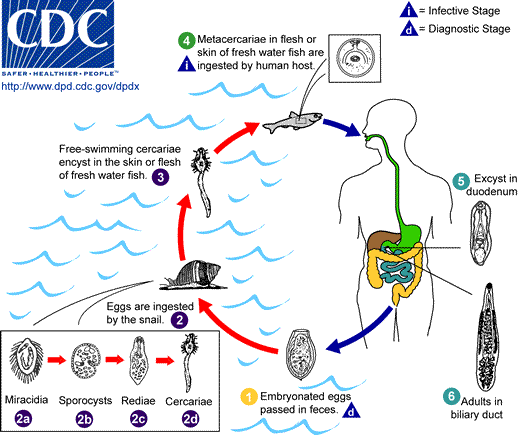Opisthorchis infection
Editor-In-Chief: C. Michael Gibson, M.S., M.D. [1]
Please Take Over This Page and Apply to be Editor-In-Chief for this topic: There can be one or more than one Editor-In-Chief. You may also apply to be an Associate Editor-In-Chief of one of the subtopics below. Please mail us [2] to indicate your interest in serving either as an Editor-In-Chief of the entire topic or as an Associate Editor-In-Chief for a subtopic. Please be sure to attach your CV and or biographical sketch.
Overview
Related Key Words and Synonyms:
Epidemiology and Demographics
O. viverrini is found mainly in northeast Thailand, Laos, and Kampuchea. O. felineus is found mainly in Europe and Asia, including the former Soviet Union.
Pathophysiology & Etiology
Etiologic agent:
Trematodes (flukes) Opisthorchis viverrini (Southeast Asian liver fluke) and O. felineus (cat liver fluke).
Life cycle:

The adult flukes deposit fully developed eggs that are passed in the feces 1.
After ingestion by a suitable snail (first intermediate host) 2, the eggs release miracidia 2a, which undergo in the snail several developmental stages (sporocysts 2b, rediae 2c, cercariae 2d).
Cercariae are released from the snail 3 and penetrate freshwater fish (second intermediate host), encysting as metacercariae in the muscles or under the scales 4.
The mammalian definitive host (cats, dogs, and various fish-eating mammals including humans) become infected by ingesting undercooked fish containing metacercariae.
After ingestion, the metacercariae excyst in the duodenum 5 and ascend through the ampulla of Vater into the biliary ducts, where they attach and develop into adults, which lay eggs after 3 to 4 weeks 6.
The adult flukes (O. viverrini: 5 mm to 10 mm by 1 mm to 2 mm; O. felineus: 7 mm to 12 mm by 2 mm to 3 mm) reside in the biliary and pancreatic ducts of the mammalian host, where they attach to the mucosa.
Diagnosis
Diagnosis is based on microscopic identification of eggs in stool specimens. However, the eggs of Opisthorchis are practically indistinguishable from those of Clonorchis.
History and Symptoms
Most infections are asymptomatic. In mild cases, manifestations include dyspepsia, abdominal pain, diarrhea or constipation. With infections of longer duration, the symptoms can be more severe, and hepatomegaly and malnutrition may be present. In rare cases, cholangitis, cholecystitis, and chlolangiocarcinoma may develop. In addition, infections due to O. felineus may present an acute phase resembling Katayama fever (schistosomiasis), with fever, facial edema, lymphadenopathy, arthralgias, rash, and eosinophilia. Chronic forms of O. felineus infections present the same manifestations as O. viverrini, with in addition involvement of the pancreatic ducts.
Treatment
Acute Pharmacotherapies
Praziquantel is the drug of choice to treat Opisthorchiasis.
"The Way I Like To Do It ..." Tips and Tricks From Clinicians Around The World
Suggested Revisions to the Current Guidelines
References
Acknowledgements
The content on this page was first contributed by: C. Michael Gibson, M.S., M.D.
Template:SIB